Micro-Credit and Risk Management in Development
VerifiedAdded on 2023/06/07
|7
|1418
|293
AI Summary
This article discusses the impact of microfinance on poverty eradication, challenges facing microfinance, and more. It highlights the positive impacts of microfinance on poor communities such as increased income, increased access to schooling and housing facilities, efficiency in the case of farmers involved in microfinance in Punjab among other positive impacts. However, it also argues that there is little faith in the poverty eradication power of microfinance institutions due to high likelihood of debt for poor communities, mismanagement of funds, misconceptions about the working of microfinance thus limited benefits and inadequate donor funding.
Contribute Materials
Your contribution can guide someone’s learning journey. Share your
documents today.
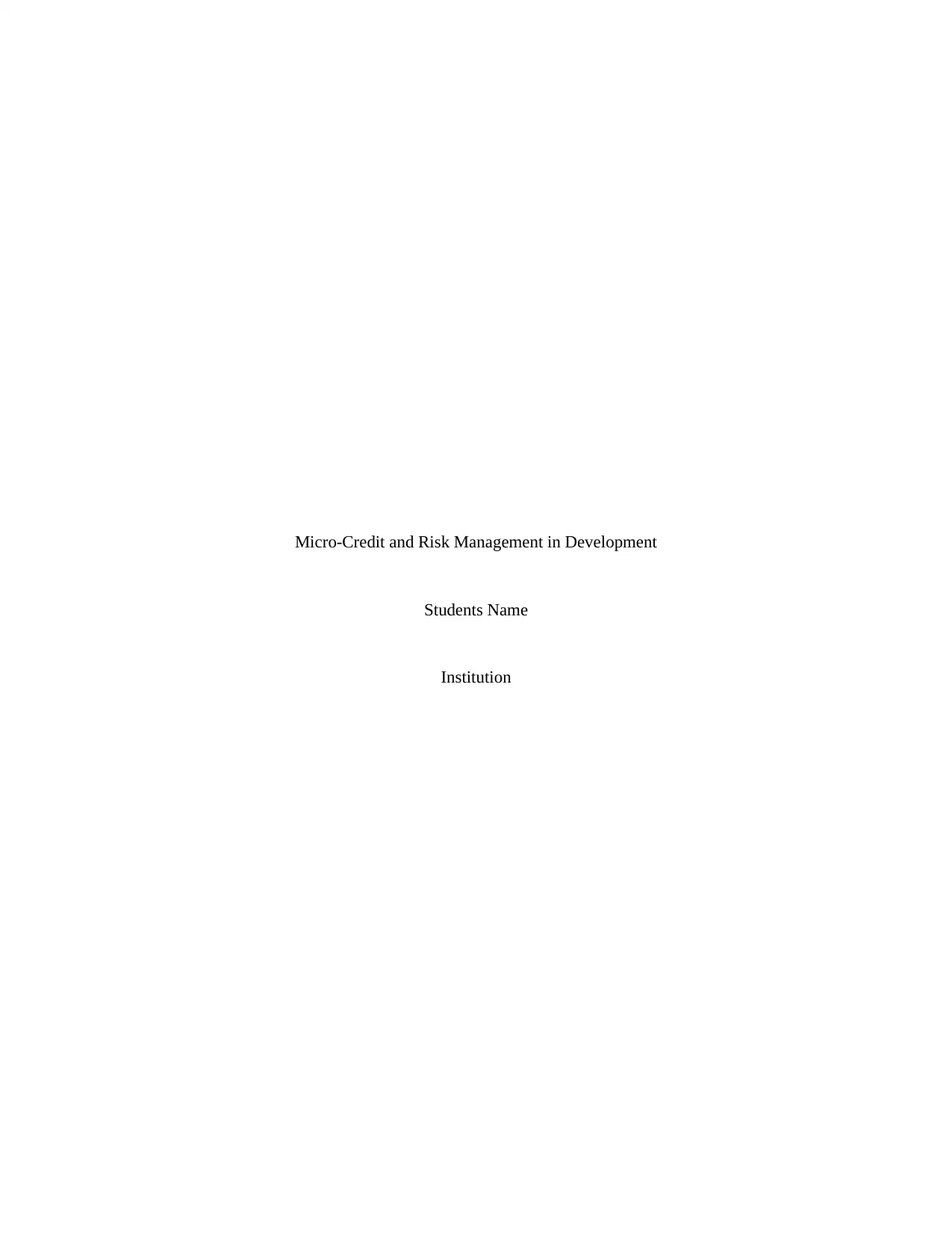
Micro-Credit and Risk Management in Development
Students Name
Institution
Students Name
Institution
Secure Best Marks with AI Grader
Need help grading? Try our AI Grader for instant feedback on your assignments.
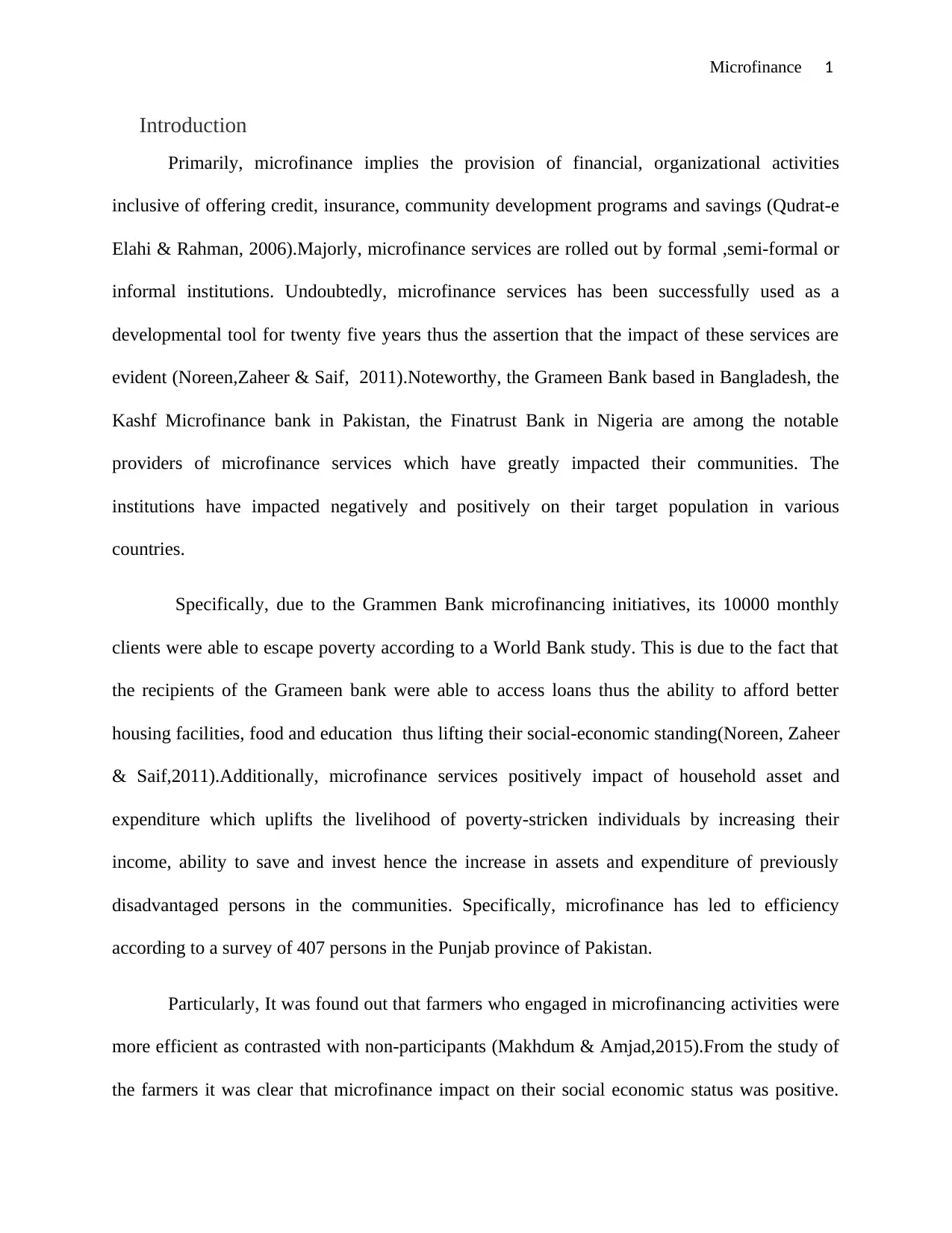
Microfinance 1
Introduction
Primarily, microfinance implies the provision of financial, organizational activities
inclusive of offering credit, insurance, community development programs and savings (Qudrat-e
Elahi & Rahman, 2006).Majorly, microfinance services are rolled out by formal ,semi-formal or
informal institutions. Undoubtedly, microfinance services has been successfully used as a
developmental tool for twenty five years thus the assertion that the impact of these services are
evident (Noreen,Zaheer & Saif, 2011).Noteworthy, the Grameen Bank based in Bangladesh, the
Kashf Microfinance bank in Pakistan, the Finatrust Bank in Nigeria are among the notable
providers of microfinance services which have greatly impacted their communities. The
institutions have impacted negatively and positively on their target population in various
countries.
Specifically, due to the Grammen Bank microfinancing initiatives, its 10000 monthly
clients were able to escape poverty according to a World Bank study. This is due to the fact that
the recipients of the Grameen bank were able to access loans thus the ability to afford better
housing facilities, food and education thus lifting their social-economic standing(Noreen, Zaheer
& Saif,2011).Additionally, microfinance services positively impact of household asset and
expenditure which uplifts the livelihood of poverty-stricken individuals by increasing their
income, ability to save and invest hence the increase in assets and expenditure of previously
disadvantaged persons in the communities. Specifically, microfinance has led to efficiency
according to a survey of 407 persons in the Punjab province of Pakistan.
Particularly, It was found out that farmers who engaged in microfinancing activities were
more efficient as contrasted with non-participants (Makhdum & Amjad,2015).From the study of
the farmers it was clear that microfinance impact on their social economic status was positive.
Introduction
Primarily, microfinance implies the provision of financial, organizational activities
inclusive of offering credit, insurance, community development programs and savings (Qudrat-e
Elahi & Rahman, 2006).Majorly, microfinance services are rolled out by formal ,semi-formal or
informal institutions. Undoubtedly, microfinance services has been successfully used as a
developmental tool for twenty five years thus the assertion that the impact of these services are
evident (Noreen,Zaheer & Saif, 2011).Noteworthy, the Grameen Bank based in Bangladesh, the
Kashf Microfinance bank in Pakistan, the Finatrust Bank in Nigeria are among the notable
providers of microfinance services which have greatly impacted their communities. The
institutions have impacted negatively and positively on their target population in various
countries.
Specifically, due to the Grammen Bank microfinancing initiatives, its 10000 monthly
clients were able to escape poverty according to a World Bank study. This is due to the fact that
the recipients of the Grameen bank were able to access loans thus the ability to afford better
housing facilities, food and education thus lifting their social-economic standing(Noreen, Zaheer
& Saif,2011).Additionally, microfinance services positively impact of household asset and
expenditure which uplifts the livelihood of poverty-stricken individuals by increasing their
income, ability to save and invest hence the increase in assets and expenditure of previously
disadvantaged persons in the communities. Specifically, microfinance has led to efficiency
according to a survey of 407 persons in the Punjab province of Pakistan.
Particularly, It was found out that farmers who engaged in microfinancing activities were
more efficient as contrasted with non-participants (Makhdum & Amjad,2015).From the study of
the farmers it was clear that microfinance impact on their social economic status was positive.
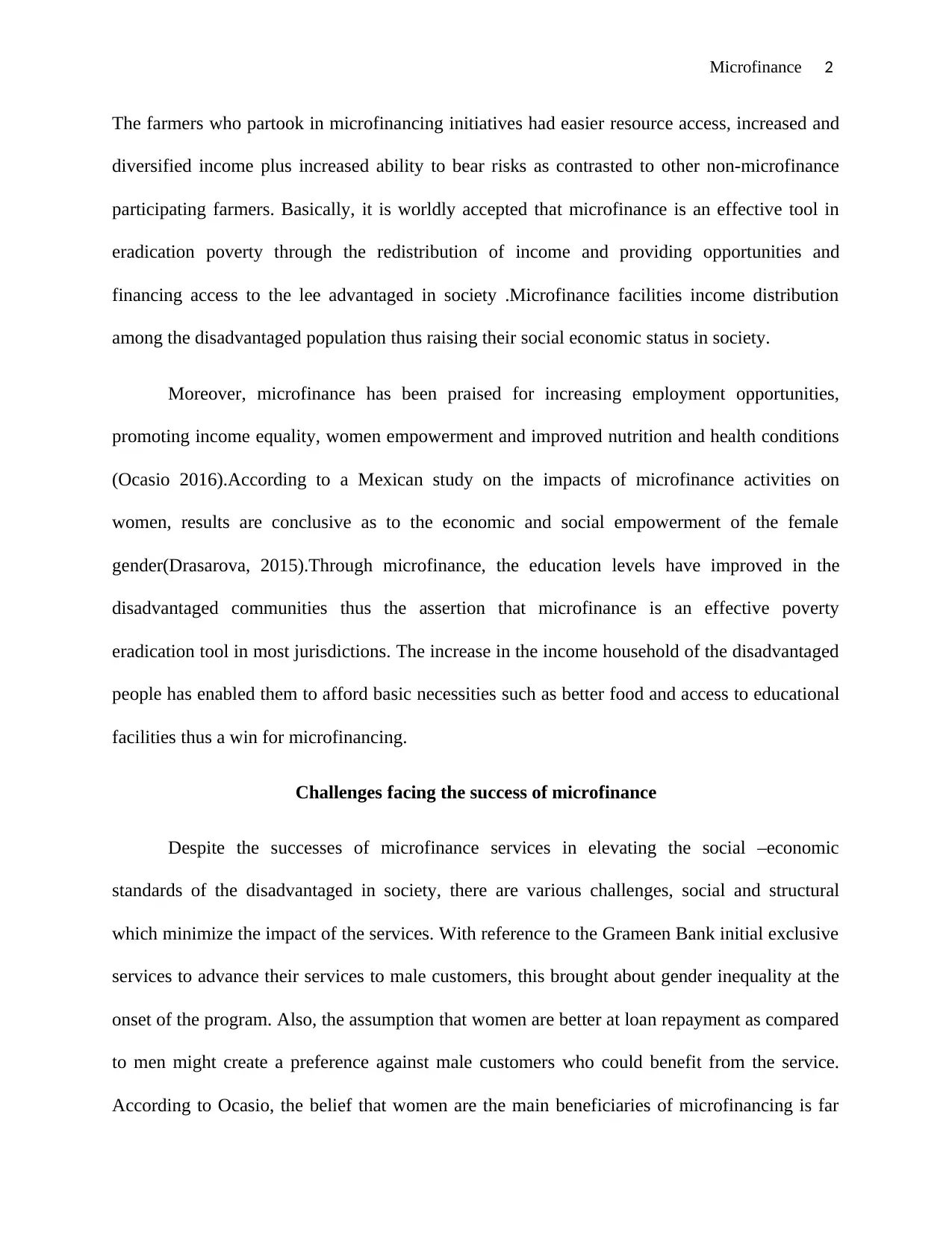
Microfinance 2
The farmers who partook in microfinancing initiatives had easier resource access, increased and
diversified income plus increased ability to bear risks as contrasted to other non-microfinance
participating farmers. Basically, it is worldly accepted that microfinance is an effective tool in
eradication poverty through the redistribution of income and providing opportunities and
financing access to the lee advantaged in society .Microfinance facilities income distribution
among the disadvantaged population thus raising their social economic status in society.
Moreover, microfinance has been praised for increasing employment opportunities,
promoting income equality, women empowerment and improved nutrition and health conditions
(Ocasio 2016).According to a Mexican study on the impacts of microfinance activities on
women, results are conclusive as to the economic and social empowerment of the female
gender(Drasarova, 2015).Through microfinance, the education levels have improved in the
disadvantaged communities thus the assertion that microfinance is an effective poverty
eradication tool in most jurisdictions. The increase in the income household of the disadvantaged
people has enabled them to afford basic necessities such as better food and access to educational
facilities thus a win for microfinancing.
Challenges facing the success of microfinance
Despite the successes of microfinance services in elevating the social –economic
standards of the disadvantaged in society, there are various challenges, social and structural
which minimize the impact of the services. With reference to the Grameen Bank initial exclusive
services to advance their services to male customers, this brought about gender inequality at the
onset of the program. Also, the assumption that women are better at loan repayment as compared
to men might create a preference against male customers who could benefit from the service.
According to Ocasio, the belief that women are the main beneficiaries of microfinancing is far
The farmers who partook in microfinancing initiatives had easier resource access, increased and
diversified income plus increased ability to bear risks as contrasted to other non-microfinance
participating farmers. Basically, it is worldly accepted that microfinance is an effective tool in
eradication poverty through the redistribution of income and providing opportunities and
financing access to the lee advantaged in society .Microfinance facilities income distribution
among the disadvantaged population thus raising their social economic status in society.
Moreover, microfinance has been praised for increasing employment opportunities,
promoting income equality, women empowerment and improved nutrition and health conditions
(Ocasio 2016).According to a Mexican study on the impacts of microfinance activities on
women, results are conclusive as to the economic and social empowerment of the female
gender(Drasarova, 2015).Through microfinance, the education levels have improved in the
disadvantaged communities thus the assertion that microfinance is an effective poverty
eradication tool in most jurisdictions. The increase in the income household of the disadvantaged
people has enabled them to afford basic necessities such as better food and access to educational
facilities thus a win for microfinancing.
Challenges facing the success of microfinance
Despite the successes of microfinance services in elevating the social –economic
standards of the disadvantaged in society, there are various challenges, social and structural
which minimize the impact of the services. With reference to the Grameen Bank initial exclusive
services to advance their services to male customers, this brought about gender inequality at the
onset of the program. Also, the assumption that women are better at loan repayment as compared
to men might create a preference against male customers who could benefit from the service.
According to Ocasio, the belief that women are the main beneficiaries of microfinancing is far
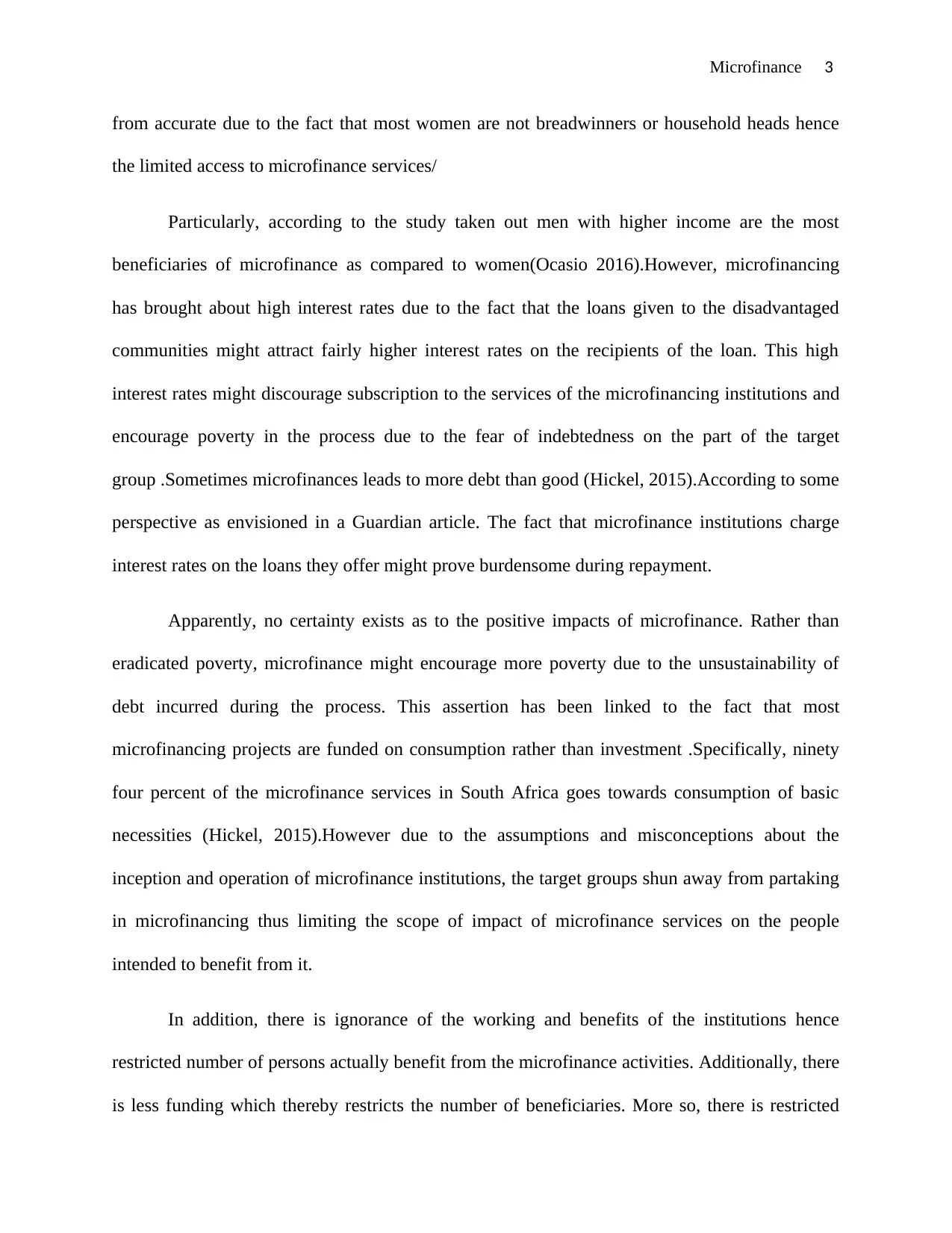
Microfinance 3
from accurate due to the fact that most women are not breadwinners or household heads hence
the limited access to microfinance services/
Particularly, according to the study taken out men with higher income are the most
beneficiaries of microfinance as compared to women(Ocasio 2016).However, microfinancing
has brought about high interest rates due to the fact that the loans given to the disadvantaged
communities might attract fairly higher interest rates on the recipients of the loan. This high
interest rates might discourage subscription to the services of the microfinancing institutions and
encourage poverty in the process due to the fear of indebtedness on the part of the target
group .Sometimes microfinances leads to more debt than good (Hickel, 2015).According to some
perspective as envisioned in a Guardian article. The fact that microfinance institutions charge
interest rates on the loans they offer might prove burdensome during repayment.
Apparently, no certainty exists as to the positive impacts of microfinance. Rather than
eradicated poverty, microfinance might encourage more poverty due to the unsustainability of
debt incurred during the process. This assertion has been linked to the fact that most
microfinancing projects are funded on consumption rather than investment .Specifically, ninety
four percent of the microfinance services in South Africa goes towards consumption of basic
necessities (Hickel, 2015).However due to the assumptions and misconceptions about the
inception and operation of microfinance institutions, the target groups shun away from partaking
in microfinancing thus limiting the scope of impact of microfinance services on the people
intended to benefit from it.
In addition, there is ignorance of the working and benefits of the institutions hence
restricted number of persons actually benefit from the microfinance activities. Additionally, there
is less funding which thereby restricts the number of beneficiaries. More so, there is restricted
from accurate due to the fact that most women are not breadwinners or household heads hence
the limited access to microfinance services/
Particularly, according to the study taken out men with higher income are the most
beneficiaries of microfinance as compared to women(Ocasio 2016).However, microfinancing
has brought about high interest rates due to the fact that the loans given to the disadvantaged
communities might attract fairly higher interest rates on the recipients of the loan. This high
interest rates might discourage subscription to the services of the microfinancing institutions and
encourage poverty in the process due to the fear of indebtedness on the part of the target
group .Sometimes microfinances leads to more debt than good (Hickel, 2015).According to some
perspective as envisioned in a Guardian article. The fact that microfinance institutions charge
interest rates on the loans they offer might prove burdensome during repayment.
Apparently, no certainty exists as to the positive impacts of microfinance. Rather than
eradicated poverty, microfinance might encourage more poverty due to the unsustainability of
debt incurred during the process. This assertion has been linked to the fact that most
microfinancing projects are funded on consumption rather than investment .Specifically, ninety
four percent of the microfinance services in South Africa goes towards consumption of basic
necessities (Hickel, 2015).However due to the assumptions and misconceptions about the
inception and operation of microfinance institutions, the target groups shun away from partaking
in microfinancing thus limiting the scope of impact of microfinance services on the people
intended to benefit from it.
In addition, there is ignorance of the working and benefits of the institutions hence
restricted number of persons actually benefit from the microfinance activities. Additionally, there
is less funding which thereby restricts the number of beneficiaries. More so, there is restricted
Secure Best Marks with AI Grader
Need help grading? Try our AI Grader for instant feedback on your assignments.
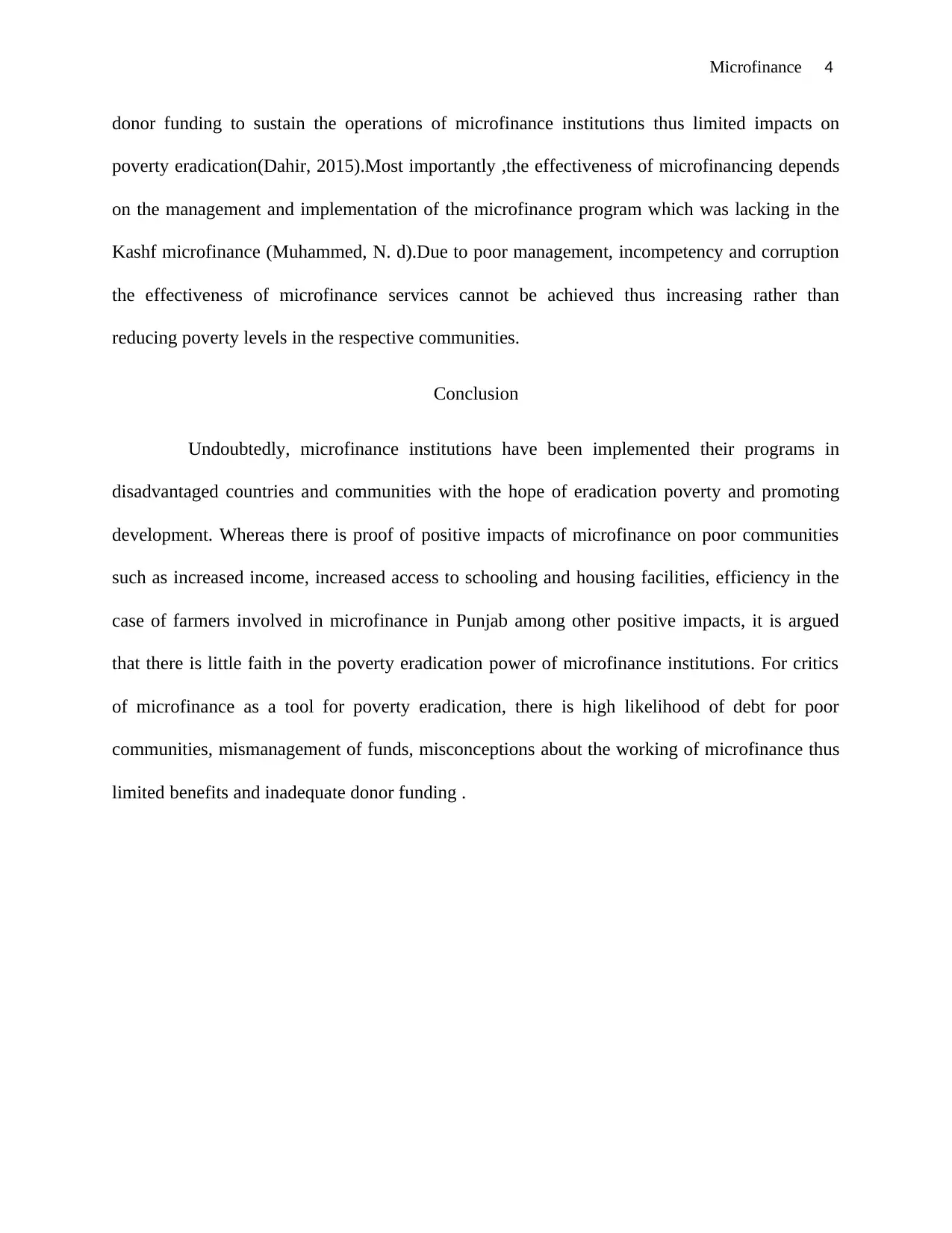
Microfinance 4
donor funding to sustain the operations of microfinance institutions thus limited impacts on
poverty eradication(Dahir, 2015).Most importantly ,the effectiveness of microfinancing depends
on the management and implementation of the microfinance program which was lacking in the
Kashf microfinance (Muhammed, N. d).Due to poor management, incompetency and corruption
the effectiveness of microfinance services cannot be achieved thus increasing rather than
reducing poverty levels in the respective communities.
Conclusion
Undoubtedly, microfinance institutions have been implemented their programs in
disadvantaged countries and communities with the hope of eradication poverty and promoting
development. Whereas there is proof of positive impacts of microfinance on poor communities
such as increased income, increased access to schooling and housing facilities, efficiency in the
case of farmers involved in microfinance in Punjab among other positive impacts, it is argued
that there is little faith in the poverty eradication power of microfinance institutions. For critics
of microfinance as a tool for poverty eradication, there is high likelihood of debt for poor
communities, mismanagement of funds, misconceptions about the working of microfinance thus
limited benefits and inadequate donor funding .
donor funding to sustain the operations of microfinance institutions thus limited impacts on
poverty eradication(Dahir, 2015).Most importantly ,the effectiveness of microfinancing depends
on the management and implementation of the microfinance program which was lacking in the
Kashf microfinance (Muhammed, N. d).Due to poor management, incompetency and corruption
the effectiveness of microfinance services cannot be achieved thus increasing rather than
reducing poverty levels in the respective communities.
Conclusion
Undoubtedly, microfinance institutions have been implemented their programs in
disadvantaged countries and communities with the hope of eradication poverty and promoting
development. Whereas there is proof of positive impacts of microfinance on poor communities
such as increased income, increased access to schooling and housing facilities, efficiency in the
case of farmers involved in microfinance in Punjab among other positive impacts, it is argued
that there is little faith in the poverty eradication power of microfinance institutions. For critics
of microfinance as a tool for poverty eradication, there is high likelihood of debt for poor
communities, mismanagement of funds, misconceptions about the working of microfinance thus
limited benefits and inadequate donor funding .
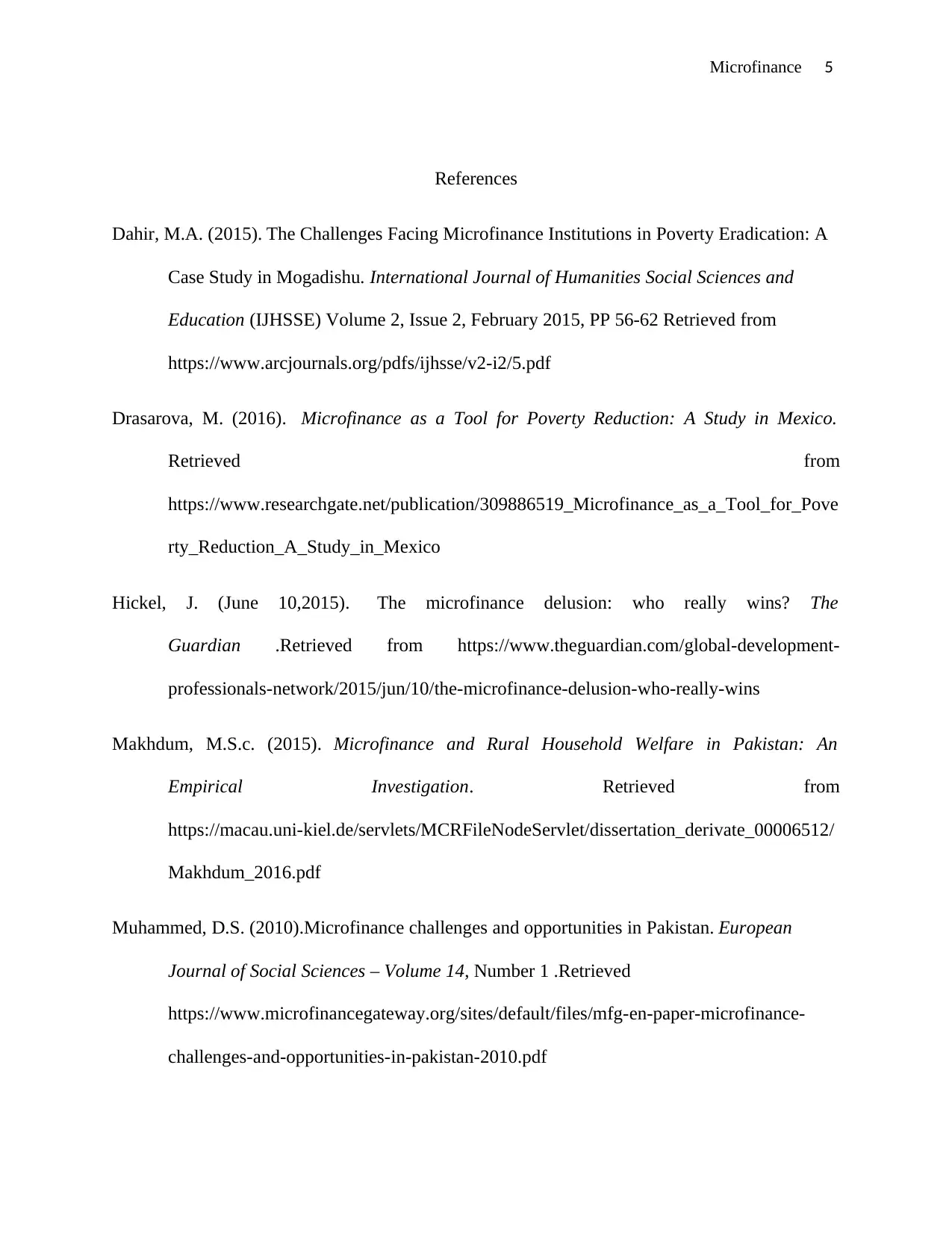
Microfinance 5
References
Dahir, M.A. (2015). The Challenges Facing Microfinance Institutions in Poverty Eradication: A
Case Study in Mogadishu. International Journal of Humanities Social Sciences and
Education (IJHSSE) Volume 2, Issue 2, February 2015, PP 56-62 Retrieved from
https://www.arcjournals.org/pdfs/ijhsse/v2-i2/5.pdf
Drasarova, M. (2016). Microfinance as a Tool for Poverty Reduction: A Study in Mexico.
Retrieved from
https://www.researchgate.net/publication/309886519_Microfinance_as_a_Tool_for_Pove
rty_Reduction_A_Study_in_Mexico
Hickel, J. (June 10,2015). The microfinance delusion: who really wins? The
Guardian .Retrieved from https://www.theguardian.com/global-development-
professionals-network/2015/jun/10/the-microfinance-delusion-who-really-wins
Makhdum, M.S.c. (2015). Microfinance and Rural Household Welfare in Pakistan: An
Empirical Investigation. Retrieved from
https://macau.uni-kiel.de/servlets/MCRFileNodeServlet/dissertation_derivate_00006512/
Makhdum_2016.pdf
Muhammed, D.S. (2010).Microfinance challenges and opportunities in Pakistan. European
Journal of Social Sciences – Volume 14, Number 1 .Retrieved
https://www.microfinancegateway.org/sites/default/files/mfg-en-paper-microfinance-
challenges-and-opportunities-in-pakistan-2010.pdf
References
Dahir, M.A. (2015). The Challenges Facing Microfinance Institutions in Poverty Eradication: A
Case Study in Mogadishu. International Journal of Humanities Social Sciences and
Education (IJHSSE) Volume 2, Issue 2, February 2015, PP 56-62 Retrieved from
https://www.arcjournals.org/pdfs/ijhsse/v2-i2/5.pdf
Drasarova, M. (2016). Microfinance as a Tool for Poverty Reduction: A Study in Mexico.
Retrieved from
https://www.researchgate.net/publication/309886519_Microfinance_as_a_Tool_for_Pove
rty_Reduction_A_Study_in_Mexico
Hickel, J. (June 10,2015). The microfinance delusion: who really wins? The
Guardian .Retrieved from https://www.theguardian.com/global-development-
professionals-network/2015/jun/10/the-microfinance-delusion-who-really-wins
Makhdum, M.S.c. (2015). Microfinance and Rural Household Welfare in Pakistan: An
Empirical Investigation. Retrieved from
https://macau.uni-kiel.de/servlets/MCRFileNodeServlet/dissertation_derivate_00006512/
Makhdum_2016.pdf
Muhammed, D.S. (2010).Microfinance challenges and opportunities in Pakistan. European
Journal of Social Sciences – Volume 14, Number 1 .Retrieved
https://www.microfinancegateway.org/sites/default/files/mfg-en-paper-microfinance-
challenges-and-opportunities-in-pakistan-2010.pdf
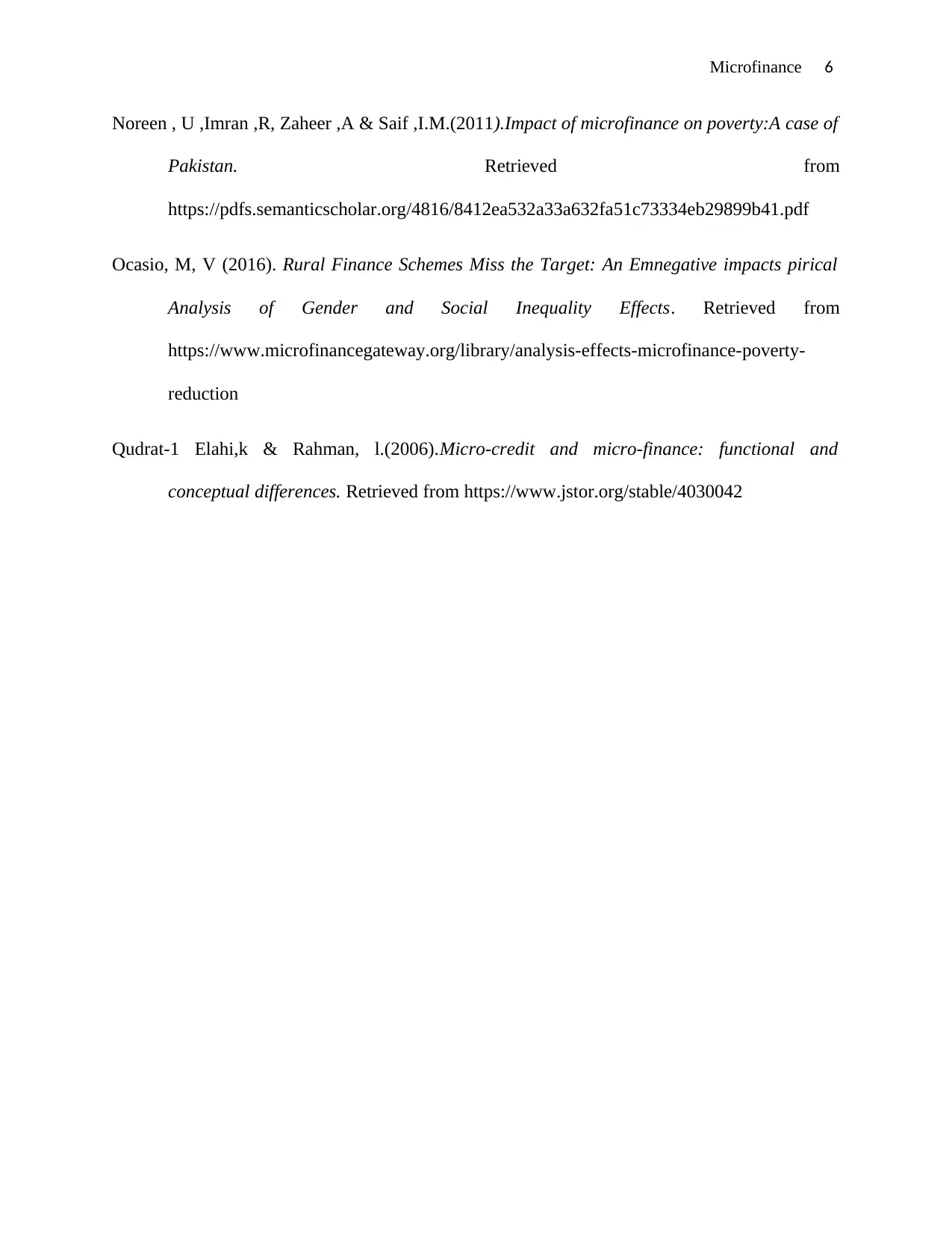
Microfinance 6
Noreen , U ,Imran ,R, Zaheer ,A & Saif ,I.M.(2011).Impact of microfinance on poverty:A case of
Pakistan. Retrieved from
https://pdfs.semanticscholar.org/4816/8412ea532a33a632fa51c73334eb29899b41.pdf
Ocasio, M, V (2016). Rural Finance Schemes Miss the Target: An Emnegative impacts pirical
Analysis of Gender and Social Inequality Effects. Retrieved from
https://www.microfinancegateway.org/library/analysis-effects-microfinance-poverty-
reduction
Qudrat-1 Elahi,k & Rahman, l.(2006).Micro-credit and micro-finance: functional and
conceptual differences. Retrieved from https://www.jstor.org/stable/4030042
Noreen , U ,Imran ,R, Zaheer ,A & Saif ,I.M.(2011).Impact of microfinance on poverty:A case of
Pakistan. Retrieved from
https://pdfs.semanticscholar.org/4816/8412ea532a33a632fa51c73334eb29899b41.pdf
Ocasio, M, V (2016). Rural Finance Schemes Miss the Target: An Emnegative impacts pirical
Analysis of Gender and Social Inequality Effects. Retrieved from
https://www.microfinancegateway.org/library/analysis-effects-microfinance-poverty-
reduction
Qudrat-1 Elahi,k & Rahman, l.(2006).Micro-credit and micro-finance: functional and
conceptual differences. Retrieved from https://www.jstor.org/stable/4030042
1 out of 7
Your All-in-One AI-Powered Toolkit for Academic Success.
+13062052269
info@desklib.com
Available 24*7 on WhatsApp / Email
![[object Object]](/_next/static/media/star-bottom.7253800d.svg)
Unlock your academic potential
© 2024 | Zucol Services PVT LTD | All rights reserved.

